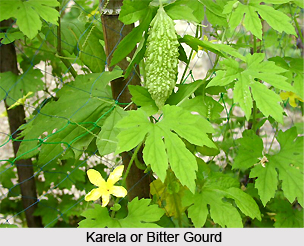Karela, Indian Medicinal Plant is a monoecious annual or perennial slender climber. This plant is cultivated all over India. This Indian medicinal plant is commonly known as `Karela` in Bengali, Gujarati, Hindi, Punjabi and Urdu. However, Karela, Bitter Gourd is known as Hagal in Kannada, Karena in Oriya, Karavella in Sanskrit, Pakal in Tamil and Kakara in Telugu. The biological name of Karela is Momordica charantia.
 The Karela is endowed with numerous medicinal properties. In Ayurveda Karela is considered as a reputed drug used to treat diabetes mellitus and is named Kamvellam. In Ayurveda the fruit is considered laxative, antidiabetic drug, cardiotonic, anathematic and a digestive stimulant. Karela, the bitter Gourd is used to treat coughs, respiratory diseases including asthma and bronchitis, fever, intestinal worms, ulcers, skin diseases, biliousness, anemia, jaundice, rheumatism, gout, liver and spleen complaints, urinary discharges, flatulence and piles.
The Karela is endowed with numerous medicinal properties. In Ayurveda Karela is considered as a reputed drug used to treat diabetes mellitus and is named Kamvellam. In Ayurveda the fruit is considered laxative, antidiabetic drug, cardiotonic, anathematic and a digestive stimulant. Karela, the bitter Gourd is used to treat coughs, respiratory diseases including asthma and bronchitis, fever, intestinal worms, ulcers, skin diseases, biliousness, anemia, jaundice, rheumatism, gout, liver and spleen complaints, urinary discharges, flatulence and piles.
This Indian Medicinal Plant, Karela is used to treat syphilis, rheumatism, splenetic disorders and ophthalmitis. Karela fruit is very useful for healing wounds as well as intractable and malignant ulcers. Both the fruit and leaves of Karela are used as an anthelminthic and for curing piles, leprosy and jaundice. The juice of the leaves is emetic and purgative; it is given to treat bilious affections, and rubbed on the soles of the feet to relieve burning, and as an ointment for sores. The astringent roots of Karela are used to treat hemorrhoids. The Ayurvedic features of Karela root is that it is used to treat ophthalmic and prolapse of the vagina.
Karela, Indian medicinal plant is a climber in which the herbaceous, tendril-bearing vine grows to 5 meter. It holds simple, flip-flop leaves 4 to12 cm across, with 3 to7 deeply separated lobes. Each Karela plant bears separate yellow male and female flowers. The fruit of this Indian medicinal plant has a distinct wartlike exterior and a two-dimensional shape. It is hollow in cross-section, with a relatively thin layer of flesh surrounding a central seed cavity filled with large flat seeds and pith. Seeds and pith appear white in unripe fruits, ripening to red; they are not intensely bitter and can be removed before cooking. The flesh of Karela is crispy and watery in texture, similar to cucumber, chayote or green bell pepper. The skin of the bitter gourd is tender and edible. The fruit is most often eaten green. Although it can also be eaten when it has started to ripen and turn yellowish, it becomes bitterer as it ripens.
The bitter fruit, Karela, comes in a variety of shapes and sizes. The typical Chinese phenotype is 20 to 30 cm long, oblong with bluntly tapering ends and pale green in color, with a gently undulating, warty surface. The Indian bitter gourds are narrower in shape with pointed ends, and a surface covered with jagged, triangular `teeth` and ridges. In central India, flowering occurs mainly in July and August, and fruiting in August and September.



















